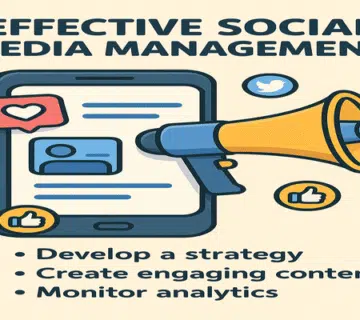Secrets of Social Media Marketing to Attract Targeted Customers
Introduction to Social Media Marketing
Social media marketing has become a primary and essential tool for attracting targeted customers in the digital era. Over recent years, platforms like Facebook, Twitter, Instagram, and LinkedIn have seen significant growth in user numbers, making them vital channels for companies seeking to promote their products and services effectively. The ability of these platforms to reach a wide and diverse audience makes them attractive for running marketing campaigns.
Social media marketing strategies are integral parts of modern marketing plans, helping companies build strong relationships with potential customers. With targeted content, companies can meet the needs and desires of their audience more effectively. By understanding demographic details and audience preferences, one can design campaigns that yield better results.
Moreover, social media marketing allows for direct interaction with customers, increasing response rates and supporting trust building. Instead of traditional communication methods that may take a long time, these platforms enable immediate feedback—enhancing the ability to adapt to customer needs and expectations. Ultimately, businesses must invest in these platforms wisely to understand their audience and strengthen relationships to achieve their marketing goals.
Defining the Target Audience
Identifying the target audience is one of the essential steps in any successful social media marketing strategy. This requires gathering precise and comprehensive information about your target segments, such as age, gender, interests, and behaviors. The more accurate this data, the more effective your campaign will be.
There are many tools available to analyze audience data. Tools like Google Analytics and Facebook Insights offer valuable insights into engagement and participation, helping pinpoint target segments accurately. Also, surveys and interviews can be used to directly gather information from potential customers, enabling a deeper understanding of their needs and desires.
Once you collect this information, it is helpful to build representative personas that reflect the traits and psychology of the target audience. These personas assist marketers in visualizing the segments better, making it easier to tailor marketing messages to their interests and needs. By understanding the audience’s social and cultural context, you can make optimal decisions about content design, message choice, and selecting the most effective platforms.
This information should be updated periodically, since customers’ interests and behaviors change over time. By maintaining accurate and current data, companies can refine their marketing strategies and build stronger, more fruitful relationships with their target audience.

Creating Engaging Content
Creating engaging content is one of the core elements of social media marketing strategies. It aims to capture the attention of targeted customers and elicit strong interaction with the brand. Content can take various forms—text, images, videos—each with its unique influence and importance in attracting audiences.
Text content is an effective means to communicate with audiences—it can deliver important messages, provide information, or inspire followers. It is important to write concise, clear copy using a style that encourages engagement—such as asking questions or prompts to comment or share. Additionally, written content should incorporate relevant keywords related to the campaign topic, which helps improve reach via search.
Images are an integral part of marketing strategies—they enhance content appeal and make messages more striking and understandable. Use high-quality, expressive images consistent with the brand identity and product or service type. You can also leverage infographics to present complex information in a simpler, more digestible form to help the audience grasp the message.
Videos have become among the most popular media in social media marketing—they deliver dynamic content that captures attention quickly. Use videos for promotions, service explanations, or customer testimonials. Videos should be short and focused since viewers prefer content that delivers value swiftly.
Choosing the Right Platform
Selecting the appropriate social media platform is one of the most important steps that shape a marketing campaign’s success. Each platform has unique features catering to different audiences, so companies must understand those features and choose the platform best aligned with their marketing goals. For instance, Facebook is among the largest and most demographically diverse platforms. It offers strong audience targeting via ads, making it ideal for reaching a broad customer base.
Instagram is visually oriented, making it perfect for brands relying on images and video—fashion, beauty, and food products tend to perform especially well there. Stories and paid ads help increase engagement and drive direct sales.
On the other hand, Twitter provides a platform for real-time communication and fast engagement with audiences. Users access live content and news, making Twitter ideal for companies wanting to boost their presence in ongoing conversations or current events. Message framing is crucial—short, appealing copy that invites interaction is best.
Thus, brands must ensure their content suits each platform’s nature. Understanding what resonates with the target audience and when to post is essential. Platform selection is integral to a social media strategy that helps achieve brand objectives and increase market presence.
Using Paid Advertising
Paid advertising is among the most effective tools in social media marketing for attracting targeted customers. By investing in paid ads, companies can extend their reach to broader and more varied audiences. Paid ads can significantly raise brand awareness and boost content engagement.
To set up effective ad campaigns, businesses should first define their goals clearly—whether increasing sales, boosting brand awareness, or collecting user data. After determining objectives, one must establish a reasonable budget to ensure the desired outcomes. Several factors should be considered when setting the budget, such as cost per click or impression. It is advisable to review past results and set a flexible budget that allows the campaign to be optimized over time.
Performance measurement is crucial for ad campaign success. With available analytics tools, you can track how audiences interact with your ads, helping understand which strategies work and which need adjustment. Core metrics include clicks, engagement, and conversion rate. These data allow companies to make rapid adjustments and optimize ongoing campaigns for the best possible results.
One of the key advantages of paid ads is targeted advertising. This feature lets you reach specific audience segments based on interests, behavior, and location. This enhances campaign efficiency and ensures the right message reaches interested individuals, thereby improving the chances of success and return on investment.
Engagement Strategies with the Audience
Engagement strategies are among the most important tools in social media marketing that help attract targeted customers and foster loyalty. Continuous communication with your audience is critical to building strong relationships, including timely replies to comments and messages. Quick responses to inquiries and comments show that the brand cares about its customers, making them feel valued and increasing chances for future engagement.
Additionally, you can host contests and events on social media to boost audience interaction. These activities are effective methods to generate new participation and increase brand awareness. Brands can invite users to join these events by creating innovative content or solutions to problems the audience may face. This encourages engagement and helps increase visibility of the company’s products and services.
Finally, asking questions is an effective strategy to boost communication. By inviting content that requires user participation, brands can better understand audience interests and preferences.
For example, polls or question prompts in posts can elicit valuable feedback and give businesses more precise insight into customers’ needs. Engagement with the audience is essential to building trusted relationships that foster customer loyalty. Through these methods, marketers can ensure the brand stays memorable and increase customer loyalty effectively.
Performance Analysis & Measuring Results
Performance analysis and measurement are essential parts of any social media marketing strategy. By using various analytics tools, marketers can understand how effective their campaigns are at attracting targeted customers and achieving set goals. Tools such as Google Analytics, Facebook Insights, and Instagram Analytics allow companies to track user behavior and analyze relevant data.
Key performance indicators (KPIs) are important factors to consider. These include metrics such as engagement rate, conversion rates, reach, and number of shares. These indicators offer valuable insights into what works well and what needs improvement. For example, if data shows low engagement, it could signal a need to improve the content to make it more appealing to the target audience.
When analyzing data, it is necessary to use results to adjust marketing strategies. Based on campaign performance, marketers can identify which content types perform best, adjust posting times, and reallocate budget to reach more relevant audiences. This dynamic approach reflects the importance of data in steering marketing strategies toward tangible results. Over the long term, optimizing social media strategies based on precise analytics helps strengthen customer relationships and build brand loyalty.

The Importance of Keeping Up with New Trends
Social media is a fast‑changing field, making it imperative for brands to stay current with new trends if they want to remain connected with their target audience. Studies show user behavior on these platforms changes continuously, requiring marketers to adapt strategies to maintain effectiveness. Companies must always be aware of the latest innovations and trends in social media.
Emerging trends in social media marketing include visual coordination, new engagement methods, and content patterns. For example, many brands now use short videos or interactive content to increase audience interaction.
These approaches can deepen emotional connection between brand and customers, boosting loyalty and sales. It is vital for companies to have a strong presence across multiple platforms (Instagram, Facebook, Twitter) to monitor what is trending and what captures followers’ attention.
Furthermore, engaging customers and soliciting their opinions on new trends is a key tool for marketers. By analyzing responses and comments, brands can adjust their plans and strategies based on what resonates with the audience. This way, companies align their marketing messages with daily changes—improving their ability to reach the target audience and motivate stronger engagement.
Conclusion & Recommendations
In conclusion, a deep understanding of effective social media marketing strategies is essential for attracting targeted customers. Social platforms are vital channels for interacting with audiences and increasing brand awareness.
Therefore, companies must use these platforms wisely to ensure they meet marketing objectives. Key points emphasized include the importance of creating engaging, relevant content; using targeted ads; and maintaining consistent interaction with users.
Among recommendations: invest in data analysis to understand customer behavior and preferences. This enables you to improve marketing strategies. Using the analytics tools available on social platforms is an effective way to enhance performance and measure results. Moreover, there must be a clear vision directing content toward the desired audience, strengthening the relationship between brand and customers.
It is also critical that companies adopt a flexible approach, as the market is volatile and full of rapid changes. The ability to adapt and continuously learn from market experiences will determine how well you attract targeted customers. Over time, these strategies contribute to increasing trust and loyalty in the brand—positively impacting the business’s bottom line.







No comment